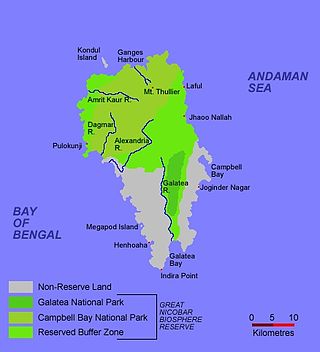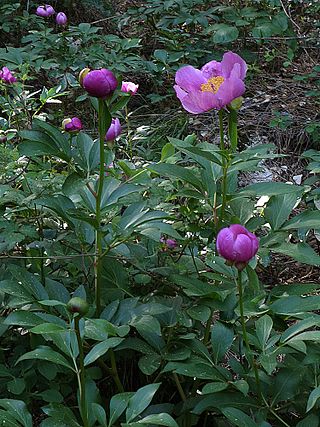
The leatherback sea turtle, sometimes called the lute turtle or leathery turtle or simply the luth, is the largest of all living turtles and the heaviest non-crocodilian reptile, reaching lengths of up to 1.8 metres and weights of 500 kilograms (1,100 lb). It is the only living species in the genus Dermochelys and family Dermochelyidae. It can easily be differentiated from other modern sea turtles by its lack of a bony shell; instead, its carapace is covered by oily flesh and flexible, leather-like skin, for which it is named.

Hoya is a genus of over 500 accepted species of tropical plants in the dogbane family, Apocynaceae. Most are native to several countries of Asia such as the Philippines, India, Thailand, Malaysia, Vietnam, Bangladesh, Indonesia, Polynesia, New Guinea, and many species are also found in Australia.

The Great Nicobar Biosphere Reserve encompasses a large part of the island of Great Nicobar, the largest of the Nicobar Islands in the Indian Union Territory of Andaman and Nicobar Islands. The Nicobars lie in the Bay of Bengal, eastern Indian Ocean, 190 km to the north of the Indonesian island of Sumatra. The Reserve has a total core area of approximately 885 km2, surrounded by a 12 km-wide "forest buffer zone". In year 2013 it was included in the list of Man and Biosphere program of UNESCO to promote sustainable development based on local community effort and sound science.

Kielmeyera is a plant genus in the family Calophyllaceae. It is endemic to South America, with a large occurrence in the Brazilian cerrados.

Kayea is a plant genus in the family Calophyllaceae.

Acacia coriacea, commonly known as river jam, wirewood, desert oak, wiry wattle or dogwood, is a tree in the family Mimosoideae of family Fabaceae. Indigenous Australians know the plant as Gunandru.

Senna artemisioides, the wormwood senna, is a species of flowering plant in the pea family Fabaceae. It is endemic to Australia, where it is found in all mainland states and territories. Other common names include silver senna, silver cassia or feathery cassia - although "cassia" generally refers to the largest-growing Cassiinae. Some of its distinct subspecies also have common names of their own.
Elaeocarpus blascoi is a species of flowering plant in the Elaeocarpaceae family. It is endemic to the Western Ghats of southern India, It is threatened by habitat loss and is Critically Endangered.
Gomphandra comosa is a species of plant in the Stemonuraceae family. It is endemic to the Andaman and Nicobar Islands. It is threatened by habitat loss.

Gomphandra is a genus of plant in family Stemonuraceae. The genus contains over 40 different species. They are dioecious trees or shrubs.

Nectandra is a genus of plant in the family Lauraceae. They are primarily Neotropical, with Nectandra coriacea being the only species reaching the southernmost United States. They have fruit with various medical effects. Sweetwood is a common name for some plants in this genus.
Posidonia coriacea is a species of seagrass that occurs in the southern waters of Australia.

Scaevola coriacea, the dwarf naupaka, is one of the ten Scaevolas, that are endemic to Hawaii.

Velutina is a genus of small sea snails, marine gastropod mollusks in the family Velutinidae.

Persoonia coriacea, commonly known as the leathery-leaf persoonia, is a species of flowering plant in the family Proteaceae and is endemic to the south-west of Western Australia. It is an erect to spreading shrub with smooth bark, spatula-shaped or elliptic to linear leaves and bright yellow flowers borne in groups of up to ten along a rachis up to 70 mm (2.8 in) long.
Tabernaemontana coriacea is a species of plant in the family Apocynaceae. It is found in western Brazil, Peru, and Bolivia.
Sampera is a South American genus of flowering plants in the tribe Liabeae within the family Asteraceae.

Bhesa indica is a flowering plant tree species in the Centroplacaceae family. It is distributed along the tropical wet evergreen forests of the Western Ghats of India. It is considered synonymous with Bhesa paniculata by some authors.

Paeonia coriacea, also known as the Corsican peony or Andalusian peony, is a species of flowering plant within the family Paeoniaceae.













